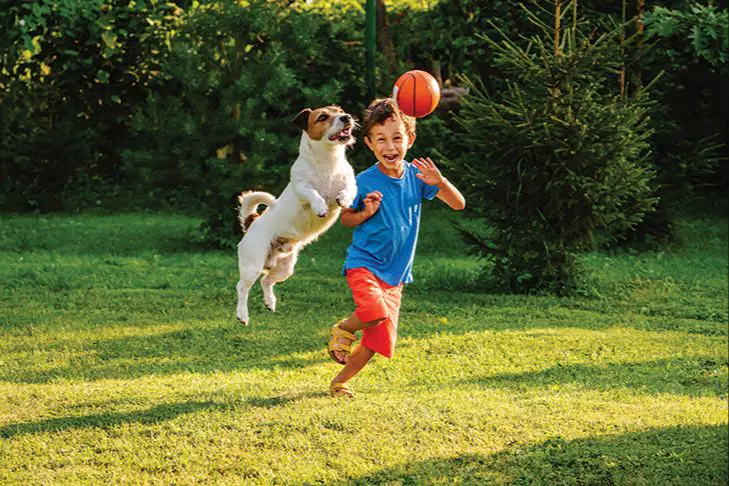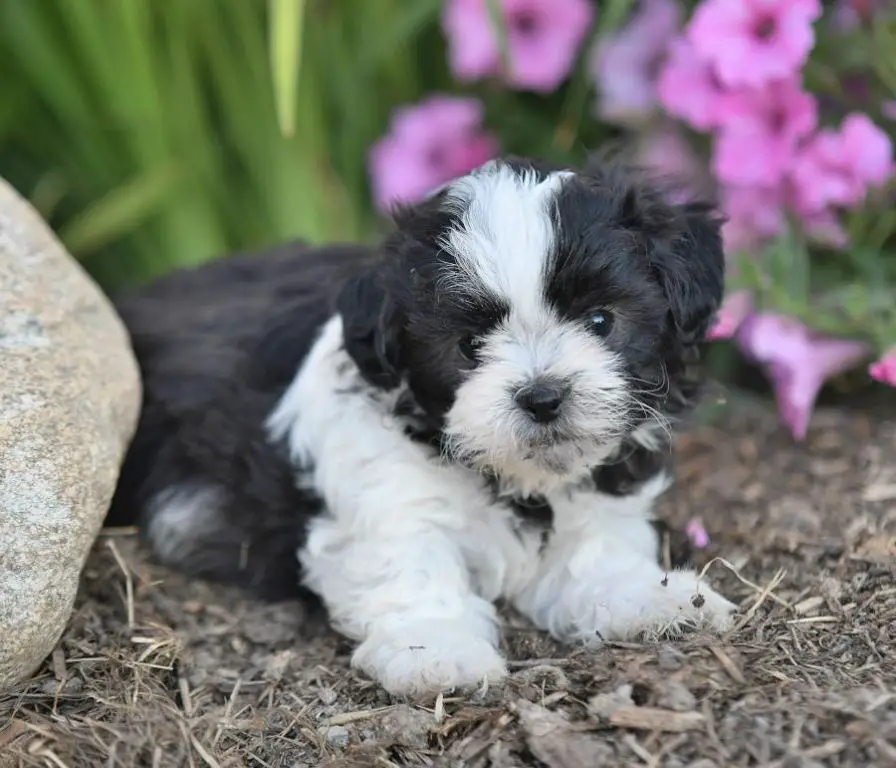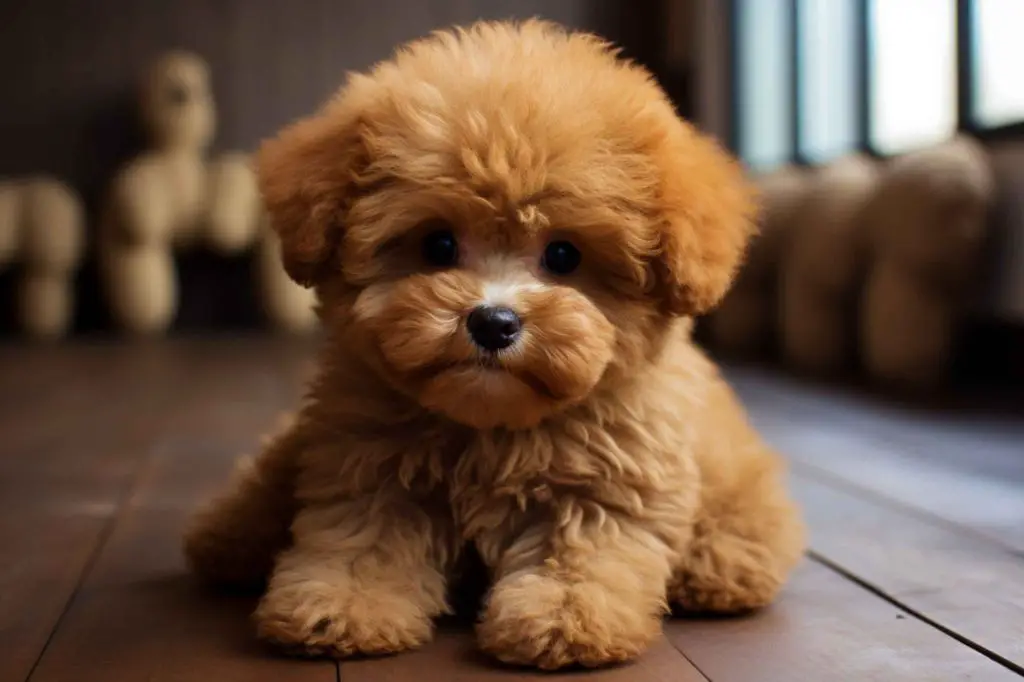What is a Teddy Bear Dog?
The Teddy Bear dog is a relatively new hybrid breed that has become popular in the last two decades due to their cute and cuddly appearance. They are a cross between the Shih Tzu and Bichon Frise breeds and were bred specifically for their adorable, teddy bear-like aesthetics.
Some key facts about the appearance of Teddy Bear dogs according to Premier Pups:
- They have a small, stocky build typically ranging from 10 to 12 inches tall and weighing between 12 to 14 pounds when fully grown.
- Their coat is soft, fluffy, and hypoallergenic.
- They commonly have tri-colored coats in black, brown, white, and tan. The fur often appears disheveled.
- Their faces are cute and round with a short snout, large expressive eyes, and a black button nose.
Overall, the Teddy Bear dog’s fluffy and adorable appearance makes them look like cuddly stuffed animals, hence the name “Teddy Bear”. Their small size, fluffy fur, and cute facial features give them a puppy-like appearance even into adulthood.
Origins of the Teddy Bear Dog
The Teddy Bear dog is a relatively new hybrid breed that was first developed in the United States in the 1990s. The exact origins are debatable, but they are largely credited to crossing the Shih Tzu and the Poodle to achieve a fluffy, teddy bear-like appearance. Some breeders also suggest infusing the Bichon Frise into the Teddy Bear bloodlines to make them smaller and fluffier. The goal was to create a friendly, hypoallergenic companion dog with a soft, non-shedding coat and cute puppy dog eyes.
The name “Teddy Bear” likely refers to the breed’s visual similarity to a stuffed bear toy. Since they were first bred in the 1990s and popularity grew in the early 2000s, Teddy Bear dogs do not have a very long history. But in their short time, they have become a favorite for their endearing temperament and adorable looks.
(Sources: https://blog.tryfi.com/teddy-bear-dogs/, https://pethelpful.com/dogs/Teddy-Bear-Puppies)
Teddy Bear Dog Breeds
There are several dog breeds used to create the teddy bear dog hybrid. Some of the most popular breeds include:
- Shichon – A mix between the Shih Tzu and Bichon Frise. Shichons are known for being friendly, playful, and low-shedding [1].
- Maltipoo – A cross between the Maltese and Poodle. Maltipoos have a charming, cuddly appearance and cheerful personality [2].
- Schnoodle – A hybrid of the Schnauzer and Poodle. Schnoodles are intelligent, obedient, and affectionate dogs with a teddy bear face.
- Cavapoo – A Cavalier King Charles Spaniel and Poodle mix. Cavapoos are friendly, alert, and make excellent companion dogs.
- Morkie – The offspring of a Maltese and a Yorkshire Terrier. Morkies are playful, loyal lapdogs known for their soft, fluffy coats.

Teddy Bear Dog Temperament
Teddy Bear dogs are known for their sweet, friendly, playful, and gentle personalities. They are extremely loving and affectionate with their owners and enjoy being involved in family activities. Teddy Bears tend to get along very well with children and other pets when properly socialized from a young age. According to Premier Pups, the Teddy Bear is an intelligent hybrid breed that aims to please their owners.
The Teddy Bear dog aims to please their owners and loves lots of praise and belly rubs. They enjoy playtime with their family and snuggling on the couch at the end of the day. Teddy Bears have an easygoing temperament and do very well in homes with adults, children, and other pets. They are adaptable to apartment living provided they get adequate daily walks and playtime. Their sweet personality makes the Teddy Bear dog an excellent companion for all types of families.
Teddy Bear Dog Care
Teddy bear dogs require regular grooming and brushing to keep their coats looking their best. Their fur can mat and tangle easily, so it’s important to brush them thoroughly at least 2-3 times per week. Use a slicker brush and metal comb to remove loose hair and prevent matting (Source).
Since teddy bear dogs have compact bodies, they do not require as much exercise as larger breeds. However, they still need daily activity to stay physically and mentally stimulated. Aim for at least 20-30 minutes of exercise per day through walks, play time, or training sessions (Source). Avoid too much high-impact exercise while they are puppies to prevent injury to their developing joints.
Teddy bear dogs are adaptable to apartment living as long as their exercise needs are met. They enjoy being around their family and do not do well left alone for long periods. Make sure to give them plenty of affection, play time, and attention every day.
Due to their small size, teddy bear dogs only need 1/2 to 1 cup of high-quality dry dog food per day. Divide this into two smaller meals. Do not overfeed them or allow them to become overweight.
Overall, teddy bear dogs make wonderful companions when provided with consistent grooming, daily exercise, training, attention, and a healthy diet tailored to their size and age.
Teddy Bear Dog Health
Like all breeds, teddy bear dogs can be prone to certain health issues. However, they tend to be relatively healthy overall when bred responsibly.
Some potential health problems to look out for include issues with their eyes and ears, patellar luxation (dislocated kneecap), and hypoglycemia (low blood sugar). Their small size also makes them more vulnerable to dental problems [1].
Reputable breeders screen their breeding dogs for health conditions to reduce the chances of passing on genetic diseases. With proper care and veterinary attention, most teddy bear dogs can live a full 12-15 years [2].
It’s recommended to have regular vet checkups, keep up with preventative care, feed a high-quality diet, and ensure plenty of exercise. This will help maintain good health and allow owners to monitor for any potential issues early on.
Finding a Teddy Bear Dog
With the rising popularity of teddy bear dogs, finding a reputable breeder is crucial. Here are some tips for locating an ethical, responsible teddy bear dog breeder:
Do your research – Get recommendations from veterinarians and other dog owners. Search online reviews and breeder directories like the Habibi Bears website. Reach out to local kennel clubs for breeder referrals.
Visit the breeder’s facility – A reputable breeder will welcome visitors to meet the puppies and see the conditions they are raised in. Watch for red flags like overcrowding, unsanitary conditions, or anxious/aggressive puppies.

Ask lots of questions – A good breeder will ask you questions too, but be prepared to inquire about breeding practices, health testing, socialization methods, contract terms, etc. Ensure they have a focus on health and breed preservation over profit.
Request medical records – At minimum the puppy should have its first set of vaccinations and a veterinary health certificate. Documentation of deworming, microchipping, and genetic health tests for parent dogs is ideal.
Look for signs of responsible breeding – Indicators include membership in breed clubs, a limited number of litters per year, well-socialized puppies raised indoors, and a commitment to take back dogs if needed.
Be wary of red flags – Avoid breeders who seem focused on money over puppy wellbeing. Also be cautious of false claims like “rare” colors and other exaggerated marketing claims.
Teddy Bear Dog Cost
The cost of a teddy bear puppy can vary quite a bit depending on the specific breed, breeder reputation and location. According to ThePricer.org, the average price range for a teddy bear puppy is between $500 and $1,800.
Some of the factors that influence the price include:
- Breed popularity – More popular small hybrid breeds like Maltipoos may be pricier.
- Breeder reputation – Well-reviewed breeders can charge more.
- Location – Puppies in high demand areas like California may cost more.
- Coat color and markings – Some colors like apricot or merle may increase price.
- Age – Younger puppies usually cost more than older puppies.
While it’s possible to find cheaper teddy bear puppies priced under $400 according to some ads, it’s important to be cautious of puppy mills and irresponsible breeders when the price seems too good to be true. Reputable breeders invest significant money into proper breeding, vet care and raising the litter.

The most budget-friendly way to get a teddy bear dog is to adopt from a rescue organization, which typically range from $50-$400. But availability of specific breeds and puppies is not guaranteed.
Teddy Bear Dogs as Pets
Teddy bear dogs make wonderful pets for families because of their affectionate, gentle, and playful personalities. These dogs tend to be very patient and tolerant with children, making them ideal family companions. Their small to medium size also makes them well-suited for homes and apartments where space may be limited.
One of the top reasons teddy bear dogs thrive as family pets is their yearning for lots of love and attention. They crave spending quality time with their owners and are often content curling up on someone’s lap for hours of petting and cuddling. Their devotion helps them form strong bonds with all members of the household.
In addition to being natural lap dogs, most teddy bear breeds are lively and energetic when playtime comes around. They’ll happily play fetch, learn tricks, and scamper around with kids. However, they’re not overly rambunctious and know when it’s time to settle down as well. Their moderate activity needs make them flexible to adapt to the family’s lifestyle.
Teddy bear dogs are also praised for their intelligence and trainability. This makes teaching them good manners like house-training much easier compared to other small breeds. Their eagerness to please further motivates them to learn commands and obey their owners.
When properly socialized from a young age, teddy bear dogs are unlikely to exhibit aggressive behaviors and do well around other pets. They tend to get along with everyone thanks to their friendly dispositions.
Overall, teddy bear dog breeds like the Shichon, Maltipoo, and Schnoodle encapsulate the perfect combination of playful and docile traits that make them a joy in family settings. Their affectionate, easygoing, and adaptive personalities explain why they shine as household companions. While teddy bear dogs require regular grooming and early training, their many positive qualities make them ideal pets for those looking for a loving four-legged friend.

The Teddy Bear Dog Controversy
The biggest controversy surrounding teddy bear dogs is that they are not considered a purebred dog breed. Rather, they are a hybrid mix of various breeds like Shih Tzus, Maltese, and Poodles.
Some dog enthusiasts object to deliberately breeding mixed dogs like teddy bears, seeing it as irresponsible compared to carefully breeding purebred dogs. Since teddy bears are not an officially recognized breed, there are no breed standards for size, appearance, temperament etc. So there can be a lot of variation between individual teddy bear puppies in a litter.
Critics argue that creating designer hybrid breeds like the teddy bear dog is more about profiting from a cute-sounding name rather than responsibly preserving breed heritage and health. They contend that cross-breeding dogs without strict standards results in greater health issues down the line.[1]
However, proponents believe designer dogs offer benefits like increased genetic diversity and lower rates of inherited diseases. They highlight that creating new mixes allows people to enjoy the positive traits of multiple breeds in one dog.[2]
The debate around the ethics and health implications of hybrid dogs like the teddy bear is ongoing. While not a purebred, teddy bears offer the combination of a lap-sized companion with the lovable teddy bear look.
